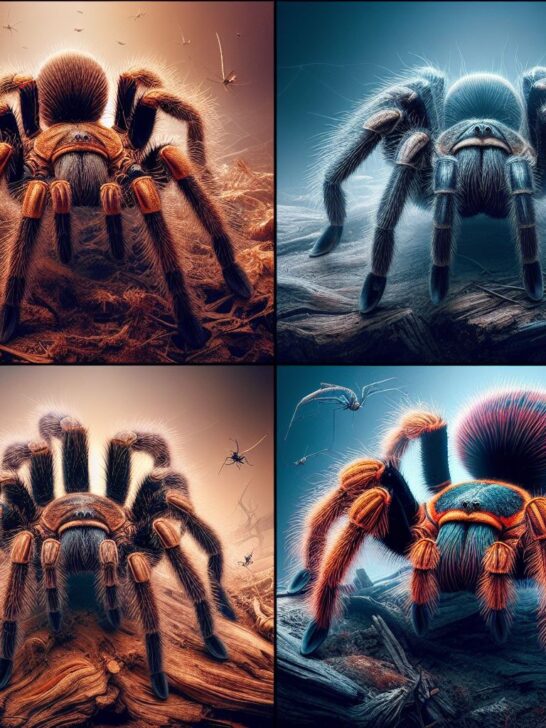Tarantulas are fascinating creatures known for their diverse appearances, behaviors, and habitats. While many tarantulas are docile and pose little threat to humans, some species are renowned for their aggressive nature and potent venom. In this guide, we will explore the world of the most aggressive and poisonous tarantulas, delving into their physical characteristics, behaviors, habitats, and more. Whether you’re a seasoned tarantula enthusiast or simply curious about these remarkable arachnids, join us on a journey into the realm of the most formidable tarantulas in the world.
Post Contents
- African Rear-Horned Baboon Tarantula – Ceratogyrus darlingi:
- Australian Whistling Tarantula – Selenocosmia crassipes:
- Bahia Scarlet Tarantula – Pterinopelma sazimai:
- Black Furry Tarantula – Aphonopelma seemanni:
- Brazilian Red and White Tarantula – Nhandu chromatus:
- Brazilian Whiteknee Tarantula – Acanthoscurria geniculata:
- Burgundy Goliath Bird Eater – Theraphosa stirmi:
- Cameroon Red Baboon Tarantula – Hysterocrates gigas:
- Chilean Rose Tarantula – Grammostola rosea:
- Chinese Black Bird-Eating Tarantula – Haplopelma schmidti:
- Cobalt Blue Tarantula – Haplopelma lividum/Cyriopagopus lividus:
- Colombian Giant Tarantula – Megaphobema robustum:
- Feather-Legged Baboon Tarantula – Stromatopelma calceatum:
- Fringed Ornamental Tarantula – Poecilotheria ornata:
- Indian Ornamental Tarantula – Poecilotheria regalis:
- Kilimanjaro Mustard Baboon Spider – Heteroscodra maculata:
- Straight Horned Baboon Spider – Ceratogyrus marshalli:
- King Baboon Tarantula – Pelinobius muticus:
- Namibian Golden Blue Leg Baboon Tarantula – Harpactirella lightfooti:
- OBT (Orange Baboon Tarantula) – Pterinochilus murinus:
- Sapphire Gooty Tarantula – Poecilotheria metallica:
- Skeleton Tarantula – Ephebopus murinus:
- Thailand Black Velvet Tarantula – Thrigmopoeus psychedelicus:
- Togo Starburst Baboon Tarantula – Heteroscodra maculata:
- Venezuelan Suntiger Tarantula – Psalmopoeus irminia:
- Summary
- FAQs (Frequently Asked Questions):
African Rear-Horned Baboon Tarantula – Ceratogyrus darlingi:
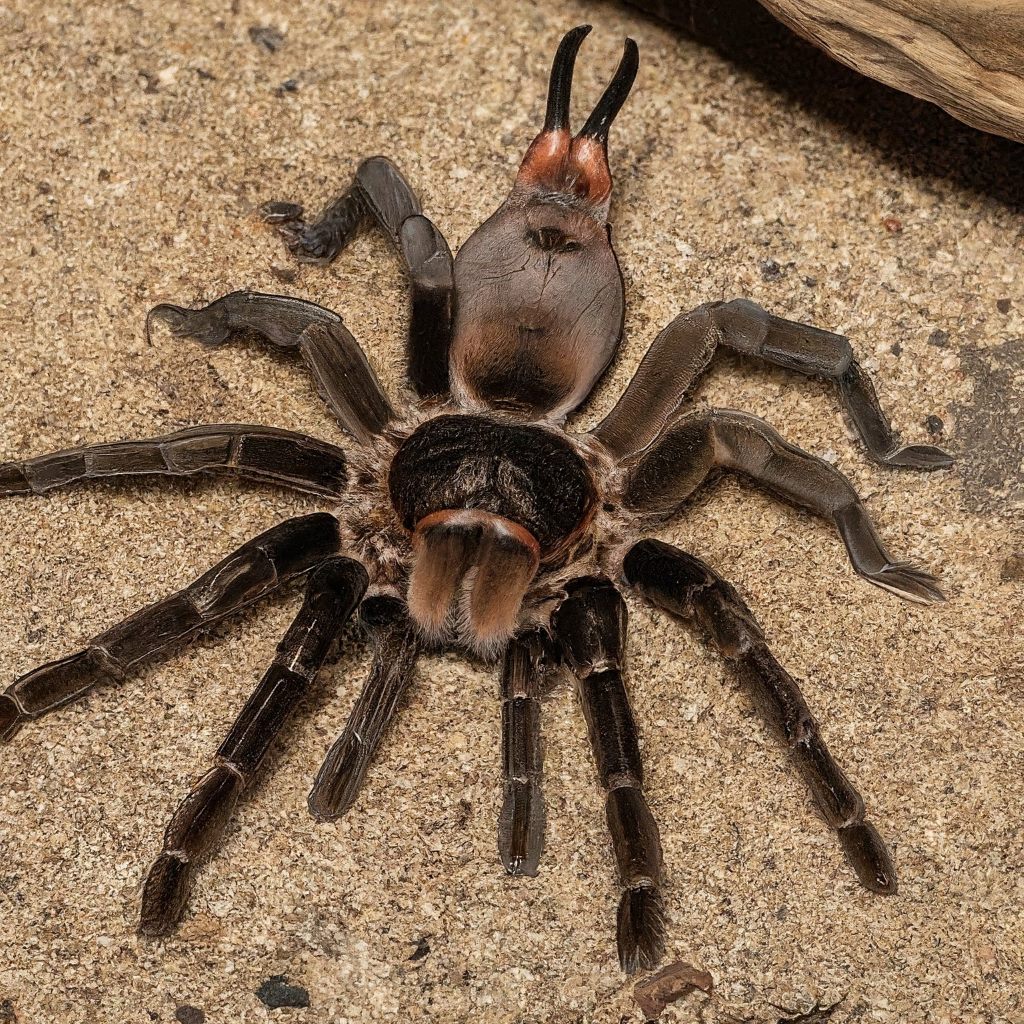
- Physical Characteristics: Ceratogyrus darlingi is characterized by its rear-facing horn on the carapace, which gives it a distinctive appearance. They have a stocky build and are typically brown or black in color.
- Size, Color, and Weight: They have a leg span of up to 5 inches and are predominantly dark brown with lighter markings. Adult females are larger and heavier than males.
- Lifespan: These tarantulas can live up to 10-15 years in captivity.
- Prey and Diet: They primarily feed on insects and small vertebrates found in their natural habitat.
- Behavior: Ceratogyrus darlingi is known for its defensive behavior and will not hesitate to strike if threatened. They are also burrowers, spending much of their time in underground tunnels.
- Habitat: Found in the savannas and grasslands of Africa, particularly in Zimbabwe and surrounding regions.
- Web: They construct silk-lined burrows for shelter and use silk to line their retreats.
- Temperament: Considered aggressive and defensive, they will readily display threat postures when disturbed.
Australian Whistling Tarantula – Selenocosmia crassipes:
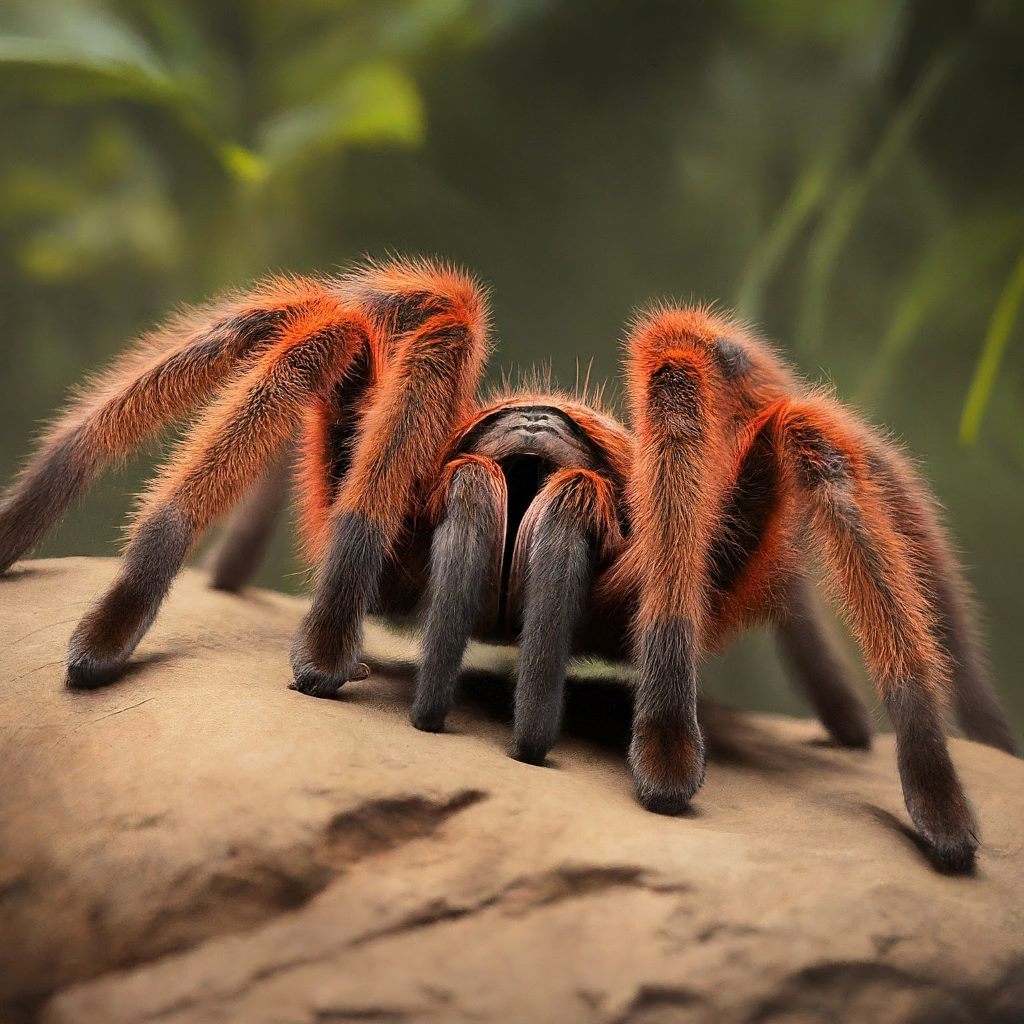
- Physical Characteristics: Selenocosmia crassipes has a robust body with a velvety appearance. They are usually dark brown or black with lighter markings.
- Size, Color, and Weight: Adults can reach a leg span of up to 6 inches and are typically dark brown with black markings.
- Lifespan: They have a lifespan of around 10-15 years in captivity.
- Prey and Diet: Their diet consists mainly of insects, although they may occasionally consume small vertebrates.
- Behavior: These tarantulas are known for their loud hissing or whistling sound produced by rubbing their chelicerae together as a warning signal. They are primarily terrestrial and will burrow to create shelter.
- Habitat: Found in the forests and woodlands of Australia, particularly in Queensland and New South Wales.
- Web: They spin silk-lined burrows for shelter and may also use silk to construct webbing for hunting.
- Temperament: While not overly aggressive, they can become defensive if provoked and may bite if threatened.
Bahia Scarlet Tarantula – Pterinopelma sazimai:
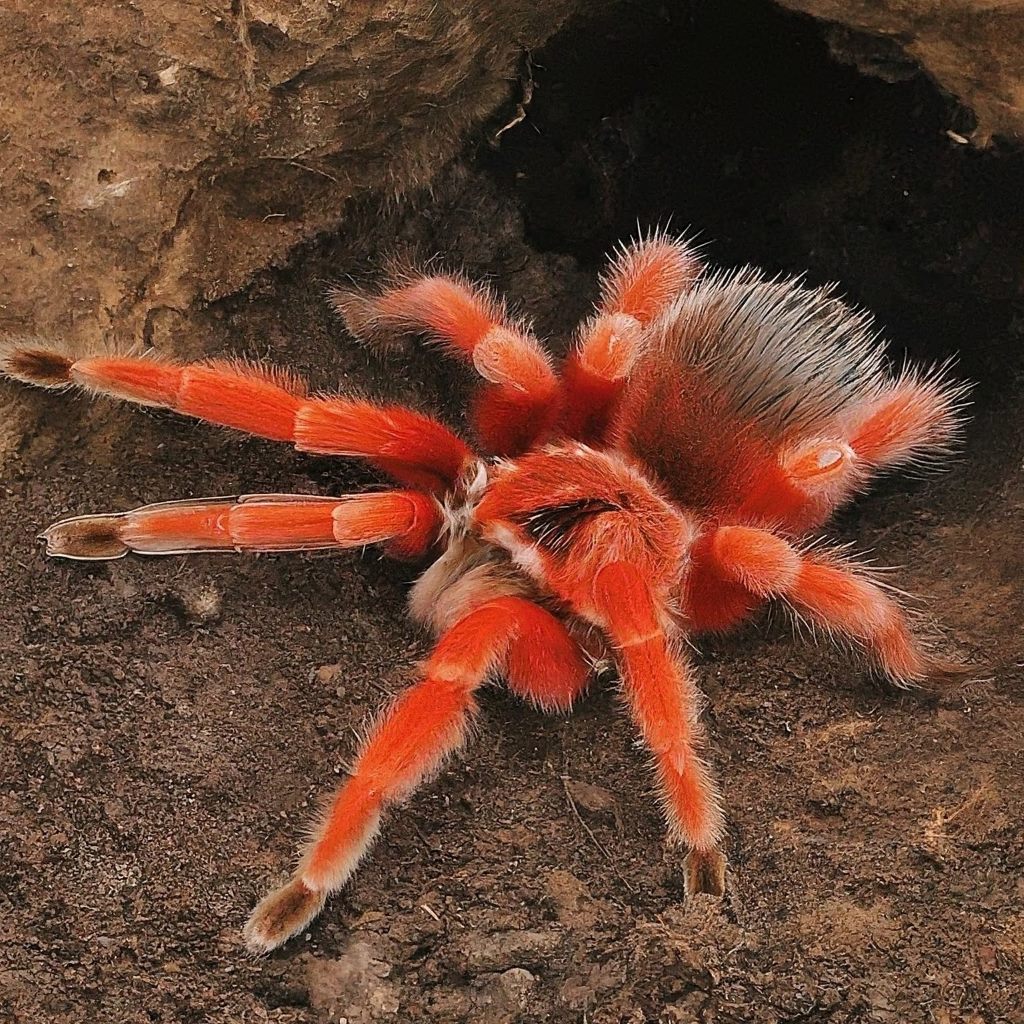
- Physical Characteristics: Pterinopelma sazimai is known for its striking scarlet-red coloration, with black markings on the abdomen and legs.
- Size, Color, and Weight: Adults have a leg span of around 4-5 inches and are predominantly bright red with contrasting black markings.
- Lifespan: They have a lifespan of around 10-15 years in captivity.
- Prey and Diet: Their diet consists mainly of insects, which they hunt actively using ambush techniques.
- Behavior: These tarantulas are generally docile but can become defensive if provoked. They are primarily terrestrial and will burrow to create shelter.
- Habitat: Found in the forests and scrublands of Brazil, particularly in the Bahia region.
- Web: They may spin silk-lined burrows for shelter but do not rely heavily on webbing for hunting.
- Temperament: Generally considered mild-mannered, but caution should be exercised when handling.
Black Furry Tarantula – Aphonopelma seemanni:
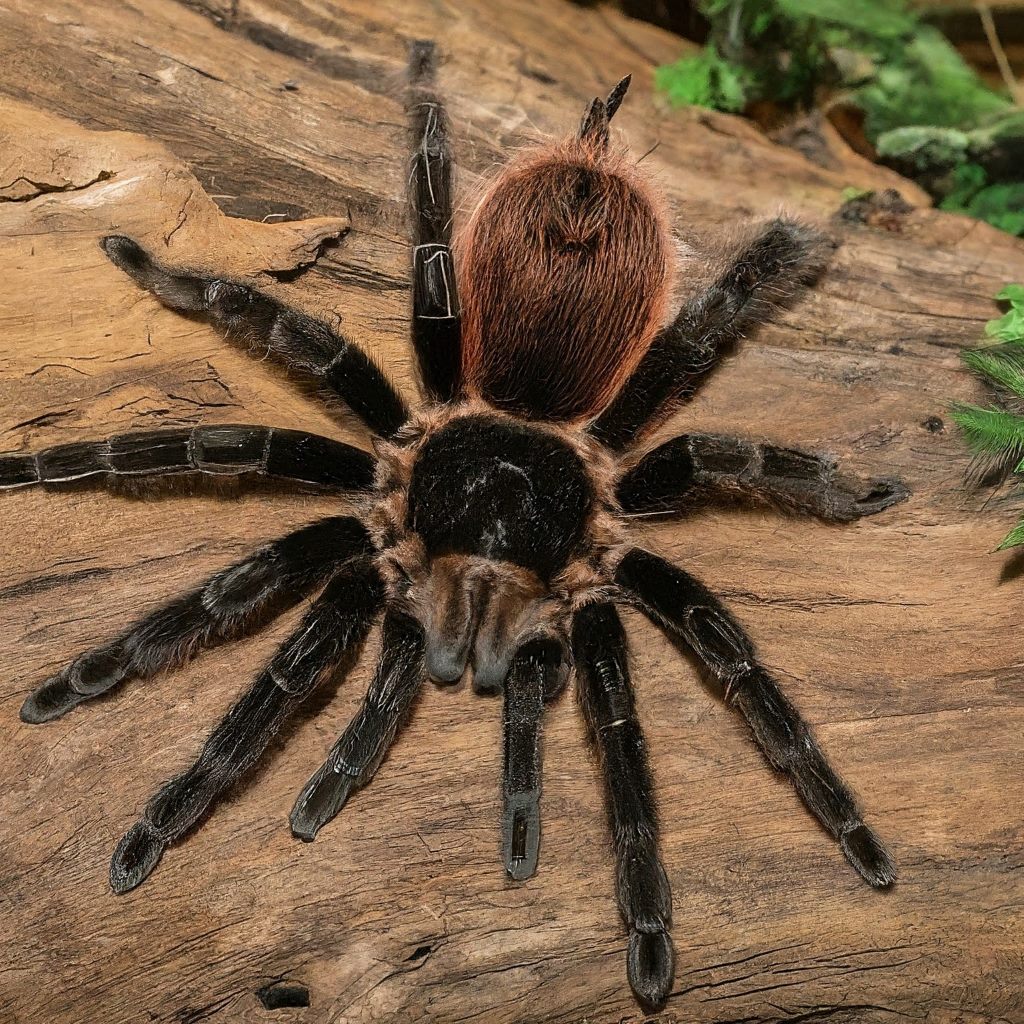
- Physical Characteristics: Aphonopelma seemanni has a dark-colored, velvety appearance with a dense covering of fine hairs, giving it a furry appearance.
- Size, Color, and Weight: Adults have a leg span of around 4-5 inches and are typically black or dark brown in color.
- Lifespan: They have a lifespan of around 10-20 years in captivity.
- Prey and Diet: Their diet consists mainly of insects and other invertebrates found in their natural habitat.
- Behavior: These tarantulas are generally docile and shy, preferring to retreat rather than confront threats. They are primarily terrestrial and will burrow to create shelter.
- Habitat: Found in a variety of habitats, including deserts, scrublands, and grasslands, throughout Central and South America.
- Web: They may spin silk-lined burrows for shelter but do not rely heavily on webbing for hunting.
- Temperament: Generally calm and easy to handle, but individual temperament may vary.
Brazilian Red and White Tarantula – Nhandu chromatus:
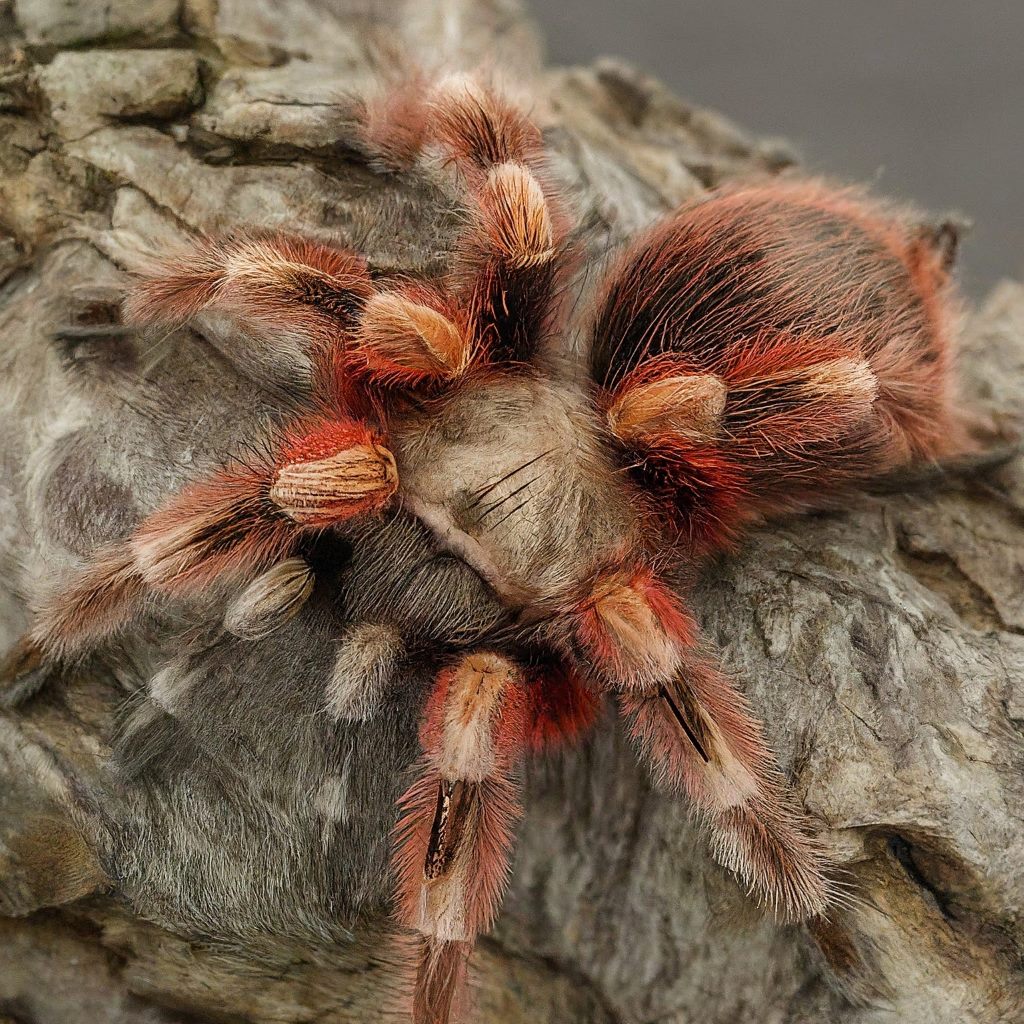
- Physical Characteristics: Nhandu chromatus is known for its striking red and white coloration, with bright red hairs covering the body and contrasting white markings.
- Size, Color, and Weight: Adults have a leg span of around 5-6 inches and are predominantly red with white stripes or bands on the legs and abdomen.
- Lifespan: They have a lifespan of around 10-15 years in captivity.
- Prey and Diet: Their diet consists mainly of insects, which they actively hunt using ambush techniques.
- Behavior: These tarantulas are generally docile but can become defensive if provoked. They are primarily terrestrial and will burrow to create shelter.
- Habitat: Found in the forests and grasslands of Brazil, particularly in the coastal regions.
- Web: They may spin silk-lined burrows for shelter but do not rely heavily on webbing for hunting.
- Temperament: Generally considered mild-mannered, but caution should be exercised when handling.
Brazilian Whiteknee Tarantula – Acanthoscurria geniculata:
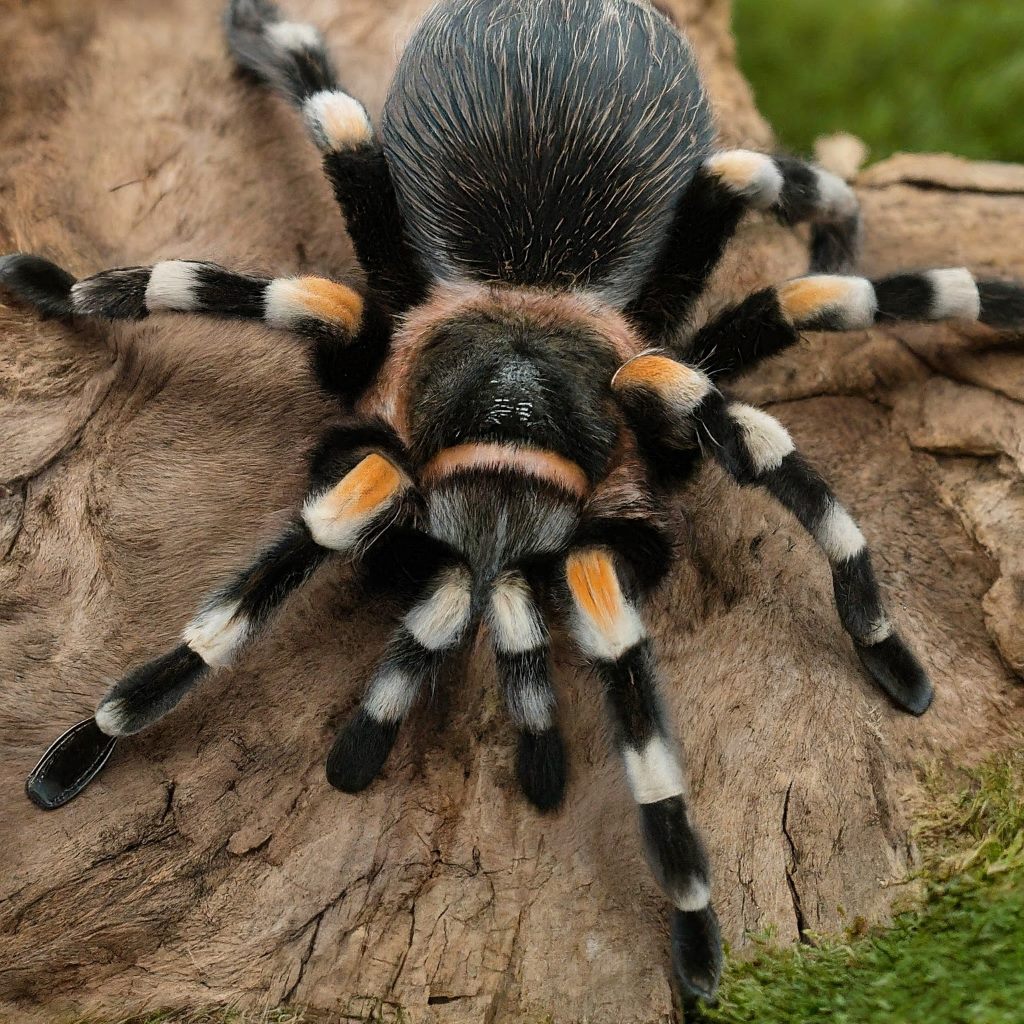
- Physical Characteristics: Acanthoscurria geniculata has a large, stocky body with distinctive white bands or stripes on the legs.
- Size, Color, and Weight: Adults have a leg span of around 7-8 inches and are predominantly brown or black with white bands on the legs.
- Lifespan: They have a lifespan of around 10-15 years in captivity.
- Prey and Diet: Their diet consists mainly of insects and other invertebrates found in their natural habitat.
- Behavior: These tarantulas are generally docile but can become defensive if provoked. They are primarily terrestrial and will burrow to create shelter.
- Habitat: Found in the forests and grasslands of Brazil, particularly in the Amazon basin.
- Web: They may spin silk-lined burrows for shelter but do not rely heavily on webbing for hunting.
- Temperament: Generally calm and easy to handle, but individual temperament may vary.
Burgundy Goliath Bird Eater – Theraphosa stirmi:
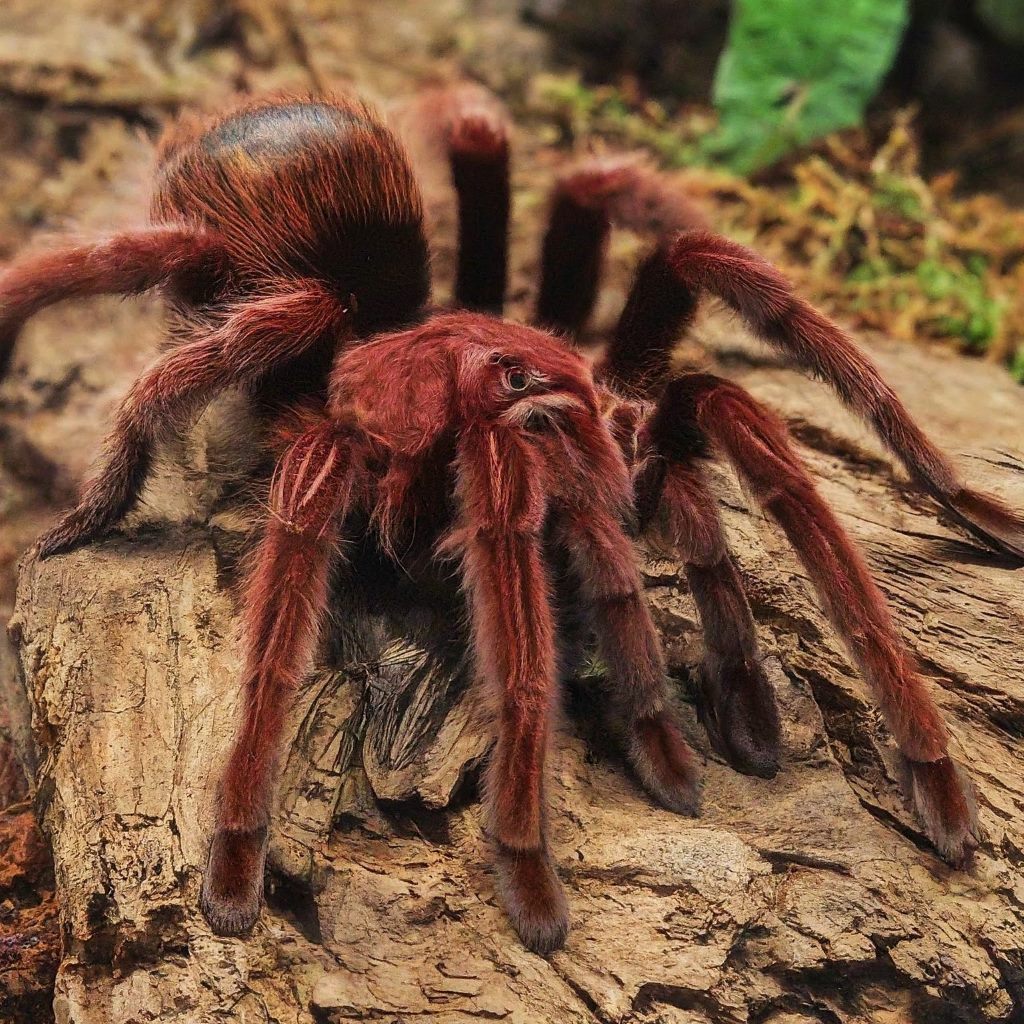
- Physical Characteristics: Theraphosa stirmi is one of the largest tarantula species, known for its massive size and robust build.
- Size, Color, and Weight: Adults can have a leg span of up to 10-12 inches and are typically dark brown or black in color.
- Lifespan: They have a lifespan of around 15-25 years in captivity.
- Prey and Diet: Their diet consists mainly of insects and small vertebrates, although they are capable of preying on larger animals.
- Behavior: These tarantulas are generally docile but can become defensive if provoked. They are primarily terrestrial and will burrow to create shelter.
- Habitat: Found in the rainforests and swamps of South America, particularly in Venezuela and Brazil.
- Web: They may spin silk-lined burrows for shelter but do not rely heavily on webbing for hunting.
- Temperament: Generally calm and easy to handle, but caution should be exercised due to their size and strength.
Cameroon Red Baboon Tarantula – Hysterocrates gigas:
- Physical Characteristics: Hysterocrates gigas has a robust body with a dark-colored carapace and abdomen, often covered in dense hairs.
- Size, Color, and Weight: Adults have a leg span of around 6-7 inches and are typically dark brown or black in color.
- Lifespan: They have a lifespan of around 10-15 years in captivity.
- Prey and Diet: Their diet consists mainly of insects and other invertebrates found in their natural habitat.
- Behavior: These tarantulas are generally docile but can become defensive if provoked. They are primarily terrestrial and will burrow to create shelter.
- Habitat: Found in the forests and grasslands of Central and West Africa, particularly in Cameroon.
- Web: They may spin silk-lined burrows for shelter but do not rely heavily on webbing for hunting.
- Temperament: Generally calm and easy to handle, but individual temperament may vary.
Chilean Rose Tarantula – Grammostola rosea:
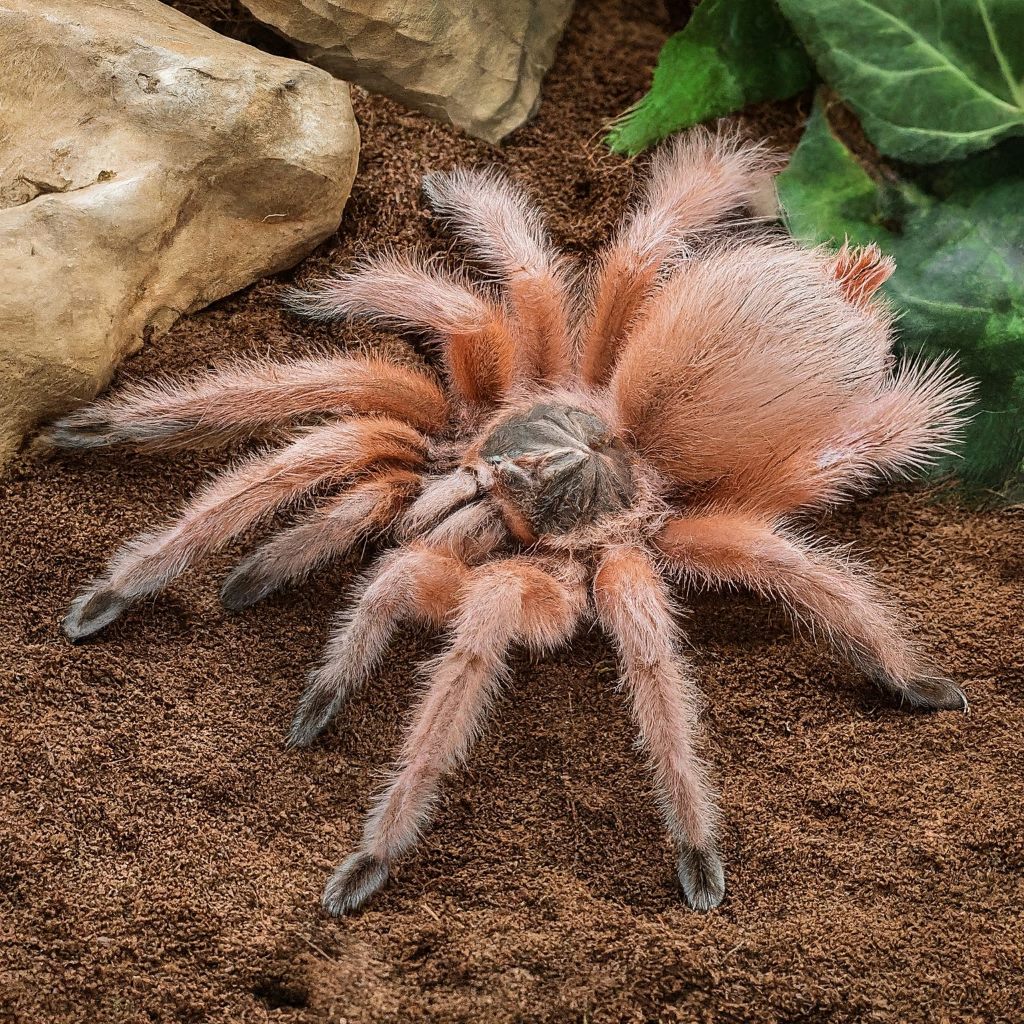
- Physical Characteristics: Grammostola rosea has a stocky body with a pinkish-brown carapace and abdomen, covered in fine hairs.
- Size, Color, and Weight: Adults have a leg span of around 4-5 inches and are typically pinkish-brown or grayish-brown in color.
- Lifespan: They have a lifespan of around 15-20 years in captivity.
- Prey and Diet: Their diet consists mainly of insects and other invertebrates found in their natural habitat.
- Behavior: These tarantulas are generally docile and slow-moving, rarely displaying aggressive behavior. They are primarily terrestrial and will burrow to create shelter.
- Habitat: Found in the deserts and scrublands of Chile, particularly in the Atacama Desert.
- Web: They may spin silk-lined burrows for shelter but do not rely heavily on webbing for hunting.
- Temperament: Generally calm and easy to handle, making them popular as pets.
Chinese Black Bird-Eating Tarantula – Haplopelma schmidti:
- Physical Characteristics: Haplopelma schmidti has a sleek and shiny appearance with a dark-colored carapace and abdomen.
- Size, Color, and Weight: Adults have a leg span of around 5-6 inches and are typically black or dark brown in color.
- Lifespan: They have a lifespan of around 10-15 years in captivity.
- Prey and Diet: Their diet consists mainly of insects and other invertebrates found in their natural habitat.
- Behavior: These tarantulas are generally secretive and reclusive, spending much of their time hiding in burrows or crevices. They are primarily terrestrial and will burrow to create shelter.
- Habitat: Found in the forests and woodlands of China, particularly in the southern regions.
- Web: They may spin silk-lined burrows for shelter but do not rely heavily on webbing for hunting.
- Temperament: Generally shy and defensive, they will retreat rather than confront threats.
Cobalt Blue Tarantula – Haplopelma lividum/Cyriopagopus lividus:
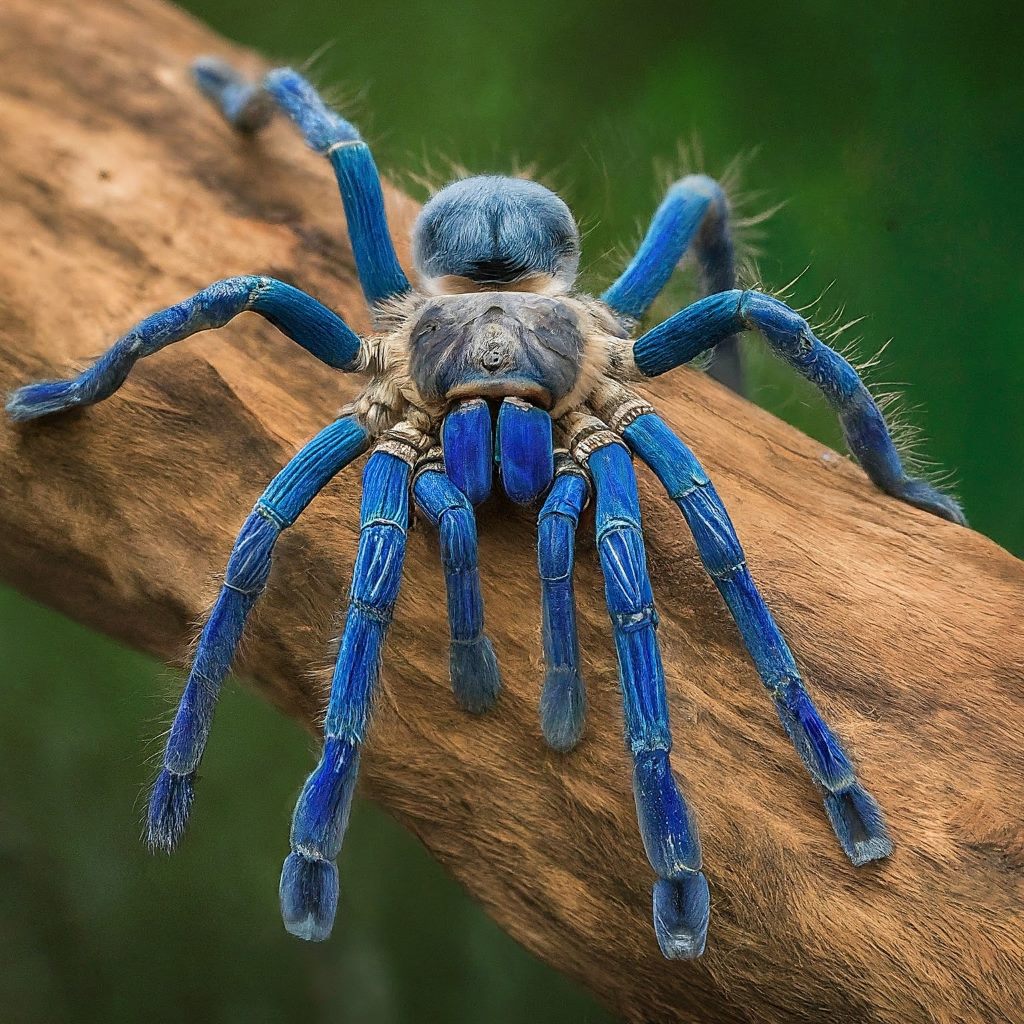
- Physical Characteristics: The Cobalt Blue Tarantula is known for its striking cobalt-blue coloration and sleek appearance.
- Size, Color, and Weight: Adults have a leg span of around 5-6 inches and are predominantly blue with black markings on the legs.
- Lifespan: They have a lifespan of around 10-15 years in captivity.
- Prey and Diet: Their diet primarily consists of insects and small invertebrates, and they are known to be voracious eaters.
- Behavior: These tarantulas are generally defensive and may exhibit aggressive behavior if threatened. They are primarily terrestrial and may burrow for shelter.
- Habitat: Found in the forests and jungles of Southeast Asia, particularly in Thailand and Myanmar.
- Web: They may spin silk-lined burrows for shelter but do not heavily rely on webbing for hunting.
- Temperament: Known for their defensive nature, they may exhibit threat displays when approached, and handling should be approached with caution.
Colombian Giant Tarantula – Megaphobema robustum:
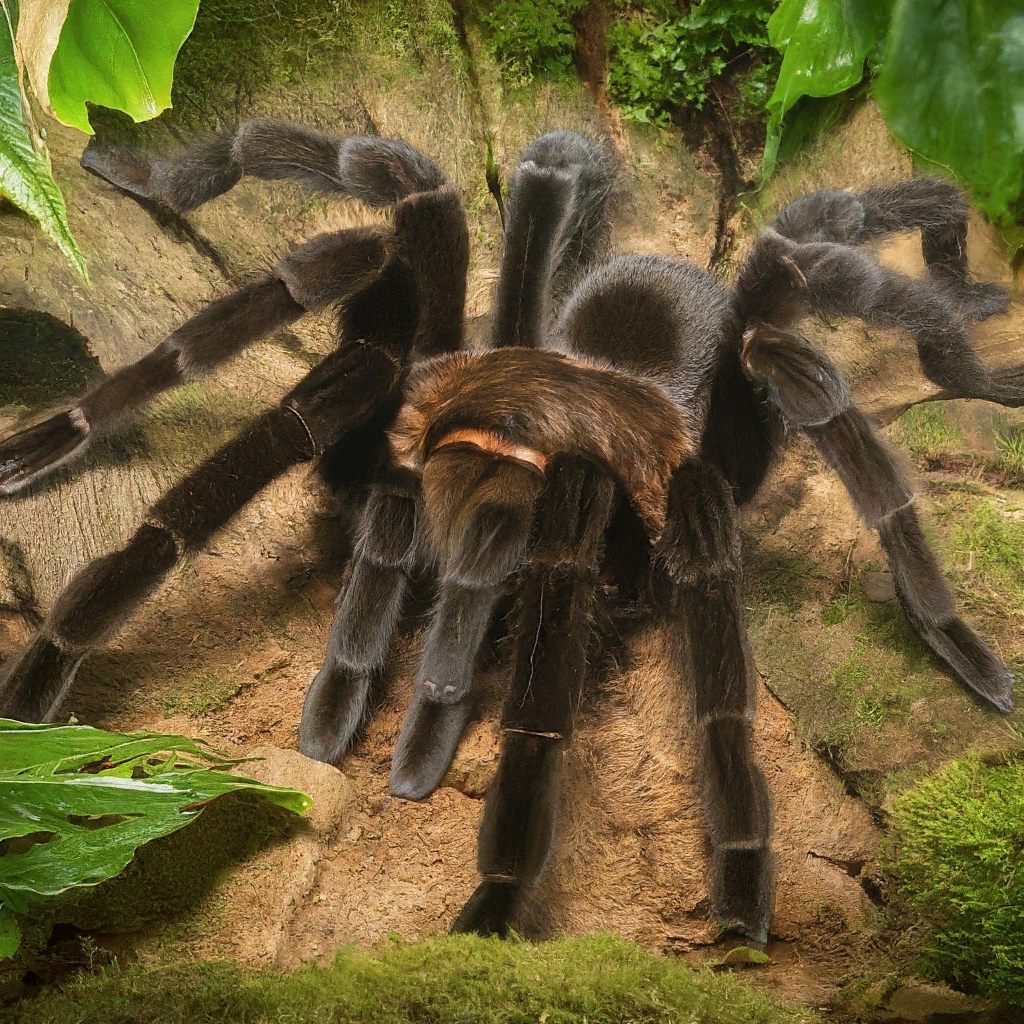
- Physical Characteristics: Megaphobema robustum is known for its large size and robust build, with a dark-colored body and dense, curly hairs.
- Size, Color, and Weight: Adults can have a leg span of up to 9-10 inches and are typically dark brown or black in color.
- Lifespan: They have a lifespan of around 15-20 years in captivity.
- Prey and Diet: Their diet mainly consists of insects and other small invertebrates, and they are known to be opportunistic feeders.
- Behavior: These tarantulas are generally docile but may become defensive if threatened. They are primarily terrestrial and may burrow for shelter.
- Habitat: Found in the rainforests and jungles of Central and South America, particularly in Colombia.
- Web: They may spin silk-lined burrows for shelter but do not heavily rely on webbing for hunting.
- Temperament: Generally calm and easy to handle, but care should be taken when handling due to their size and strength.
Feather-Legged Baboon Tarantula – Stromatopelma calceatum:
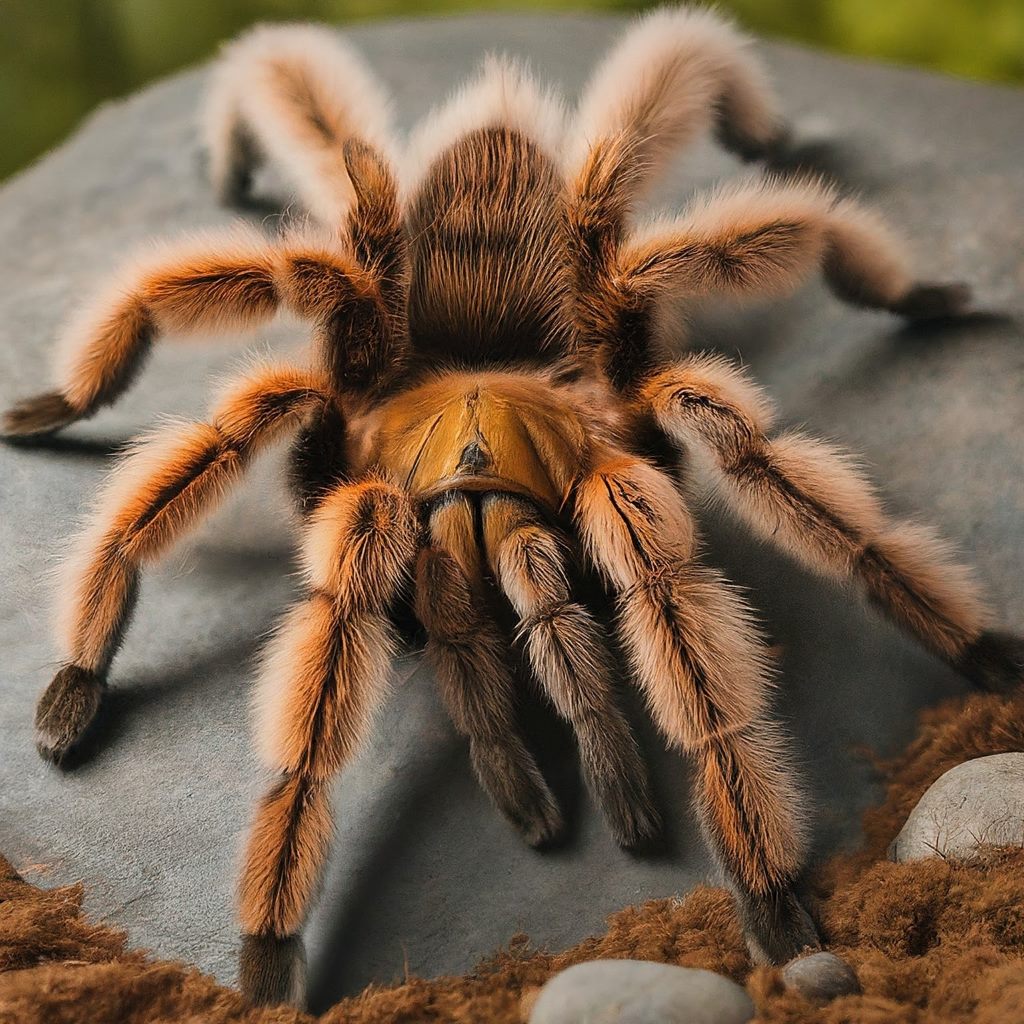
- Physical Characteristics: Stromatopelma calceatum is known for its unique appearance, with long, feathery hairs on its legs and a dark-colored body.
- Size, Color, and Weight: Adults have a leg span of around 4-5 inches and are typically brown or black in color.
- Lifespan: They have a lifespan of around 8-10 years in captivity.
- Prey and Diet: Their diet mainly consists of insects and other small invertebrates, and they are known to be agile hunters.
- Behavior: These tarantulas are generally defensive and may exhibit aggressive behavior if threatened. They are primarily terrestrial and may burrow for shelter.
- Habitat: Found in the forests and woodlands of West Africa, particularly in Cameroon and Nigeria.
- Web: They may spin silk-lined burrows for shelter but do not heavily rely on webbing for hunting.
- Temperament: Known for their defensive nature, they may bite if provoked, and handling should be approached with caution.
Fringed Ornamental Tarantula – Poecilotheria ornata:
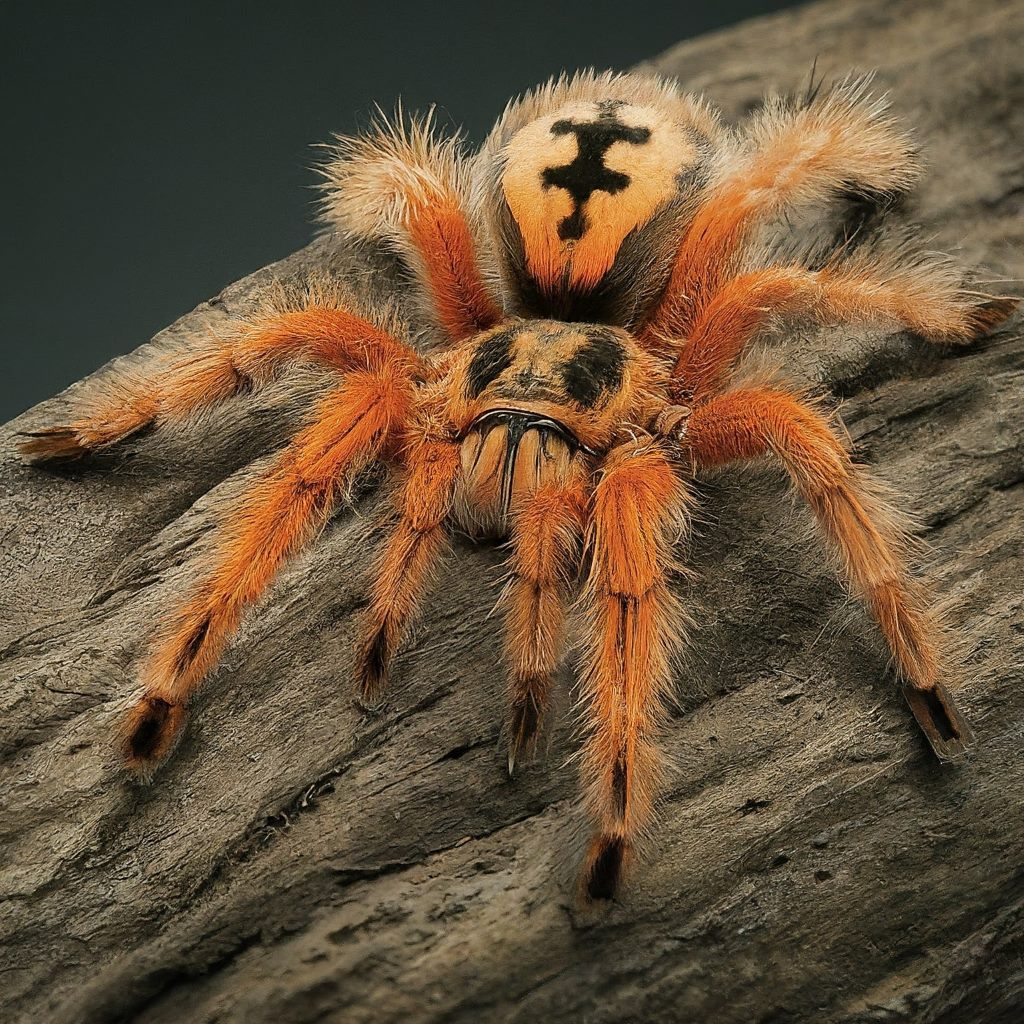
- Physical Characteristics: Poecilotheria ornata is known for its intricate patterns and vibrant colors, with fringed markings on its legs.
- Size, Color, and Weight: Adults have a leg span of around 6-7 inches and are typically brown or black with yellow or orange markings.
- Lifespan: They have a lifespan of around 10-12 years in captivity.
- Prey and Diet: Their diet mainly consists of insects and other small invertebrates, and they are known to be agile hunters.
- Behavior: These tarantulas are generally defensive and may exhibit aggressive behavior if threatened. They are arboreal and may create silk retreats in trees or foliage.
- Habitat: Found in the forests and jungles of South Asia, particularly in India and Sri Lanka.
- Web: They may spin intricate webs in trees or foliage for shelter and hunting.
- Temperament: Known for their defensive nature, they may bite if provoked, and handling should be approached with caution.
Indian Ornamental Tarantula – Poecilotheria regalis:
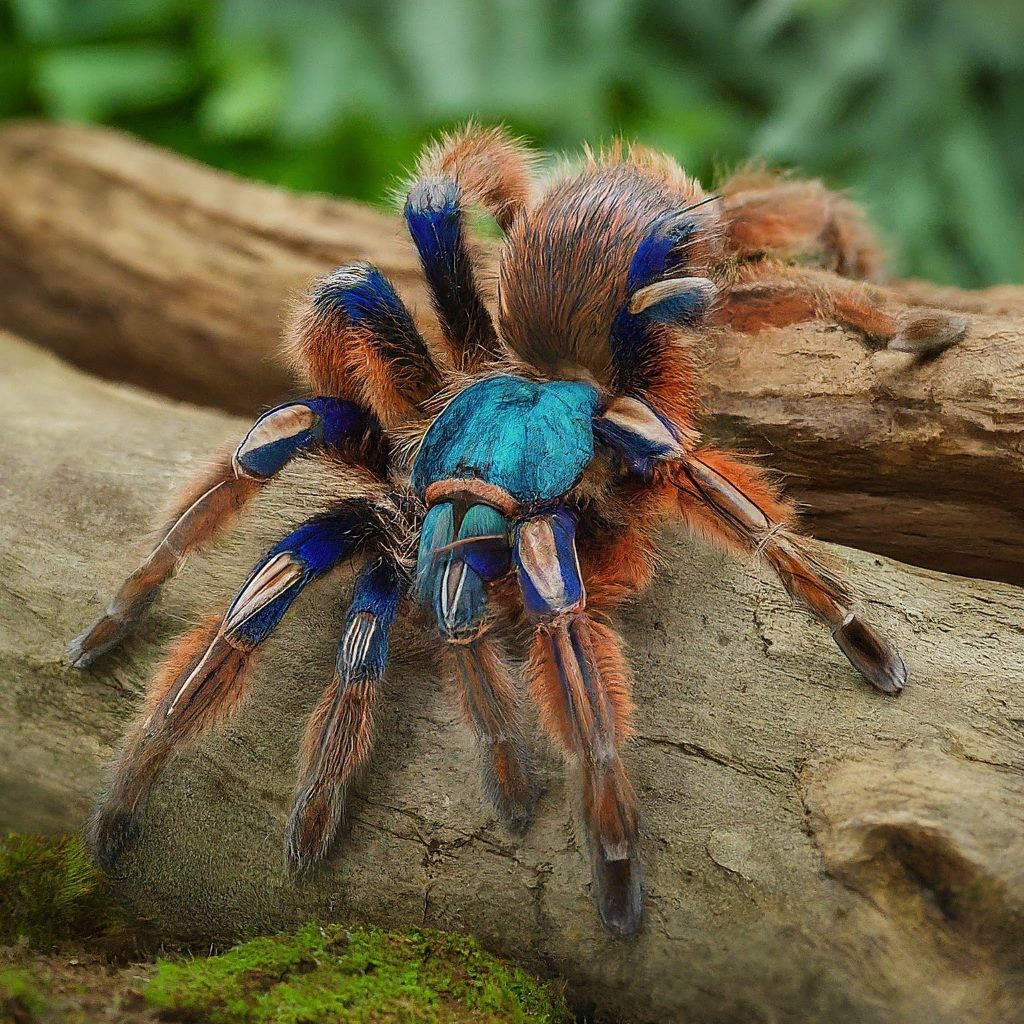
- Physical Characteristics: Poecilotheria regalis is known for its intricate patterns and vibrant colors, with distinct markings on its legs and abdomen.
- Size, Color, and Weight: Adults have a leg span of around 5-6 inches and are typically brown or black with yellow or orange markings.
- Lifespan: They have a lifespan of around 8-10 years in captivity.
- Prey and Diet: Their diet mainly consists of insects and other small invertebrates, and they are known to be agile hunters.
- Behavior: These tarantulas are generally defensive and may exhibit aggressive behavior if threatened. They are arboreal and may create silk retreats in trees or foliage.
- Habitat: Found in the forests and jungles of South Asia, particularly in India and Sri Lanka.
- Web: They may spin intricate webs in trees or foliage for shelter and hunting.
- Temperament: Known for their defensive nature, they may bite if provoked, and handling should be approached with caution.
Kilimanjaro Mustard Baboon Spider – Heteroscodra maculata:
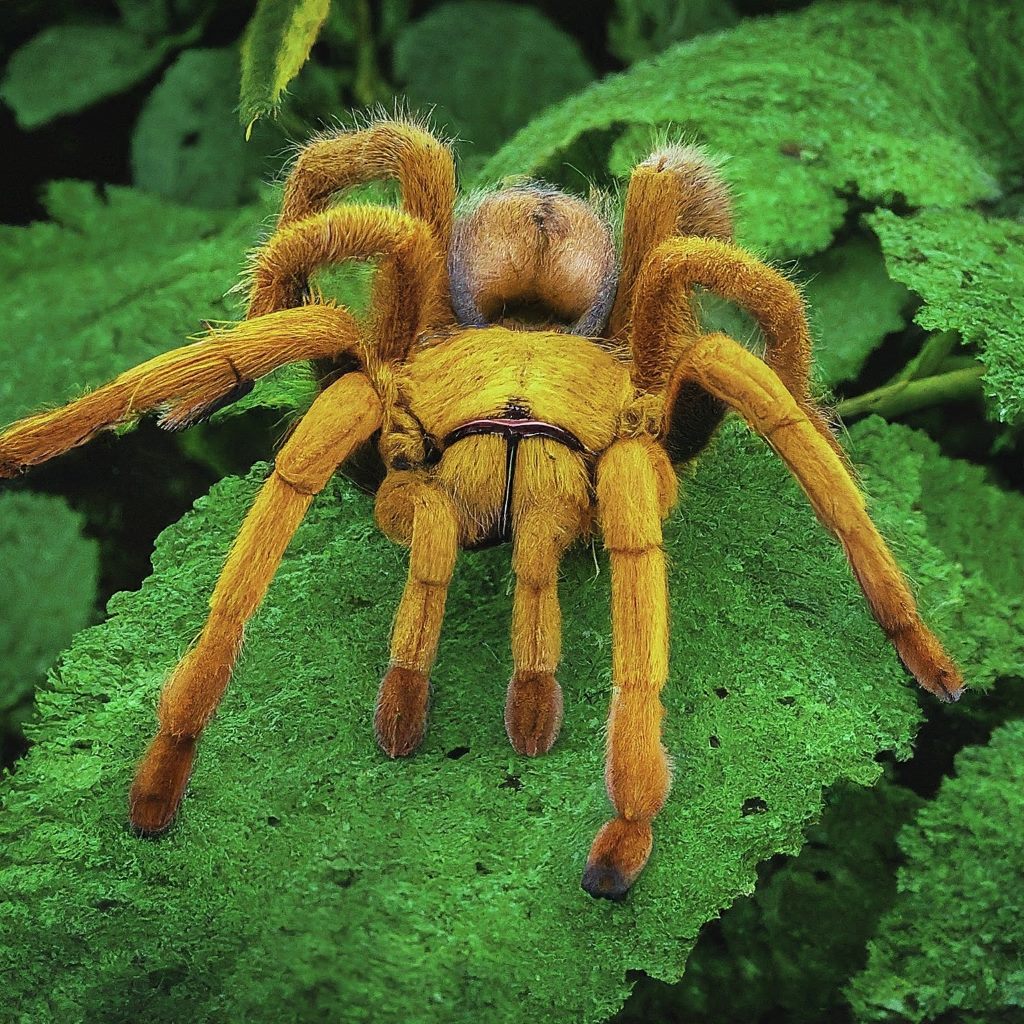
- Physical Characteristics: Heteroscodra maculata is known for its vibrant yellow coloration and distinctive patterns on its legs and abdomen.
- Size, Color, and Weight: Adults have a leg span of around 4-5 inches and are typically yellow with black markings.
- Lifespan: They have a lifespan of around 6-8 years in captivity.
- Prey and Diet: Their diet mainly consists of insects and other small invertebrates, and they are known to be fast and efficient hunters.
- Behavior: These tarantulas are highly defensive and may exhibit aggressive behavior if threatened. They are arboreal and may create silk retreats in trees or foliage.
- Habitat: Found in the forests and woodlands of East Africa, particularly in Tanzania and Kenya.
- Web: They may spin intricate webs in trees or foliage for shelter and hunting.
- Temperament: Known for their aggressive nature, they may bite if provoked, and handling should be approached with extreme caution.
Straight Horned Baboon Spider – Ceratogyrus marshalli:
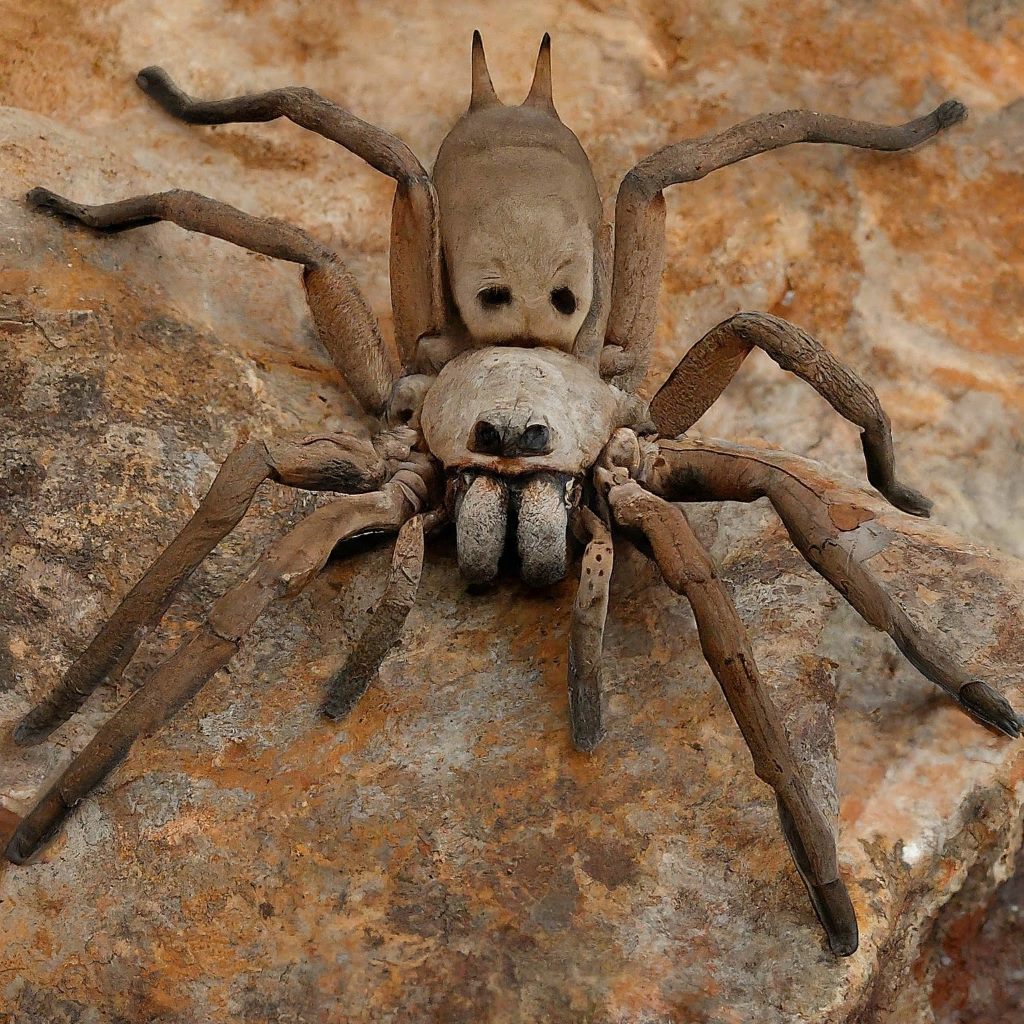
- Physical Characteristics: Ceratogyrus marshalli is known for its distinctive horn-like projections on its cephalothorax and robust build.
- Size, Color, and Weight: Adults have a leg span of around 5-6 inches and are typically brown or black with lighter markings.
- Lifespan: They have a lifespan of around 8-10 years in captivity.
- Prey and Diet: Their diet mainly consists of insects and other small invertebrates, and they are known to be opportunistic feeders.
- Behavior: These tarantulas are generally defensive and may exhibit aggressive behavior if threatened. They are terrestrial and may burrow for shelter.
- Habitat: Found in the savannas and grasslands of Southern Africa, particularly in Zimbabwe and South Africa.
- Web: They may spin silk-lined burrows for shelter but do not heavily rely on webbing for hunting.
- Temperament: Known for their defensive nature, they may bite if provoked, and handling should be approached with caution.
King Baboon Tarantula – Pelinobius muticus:
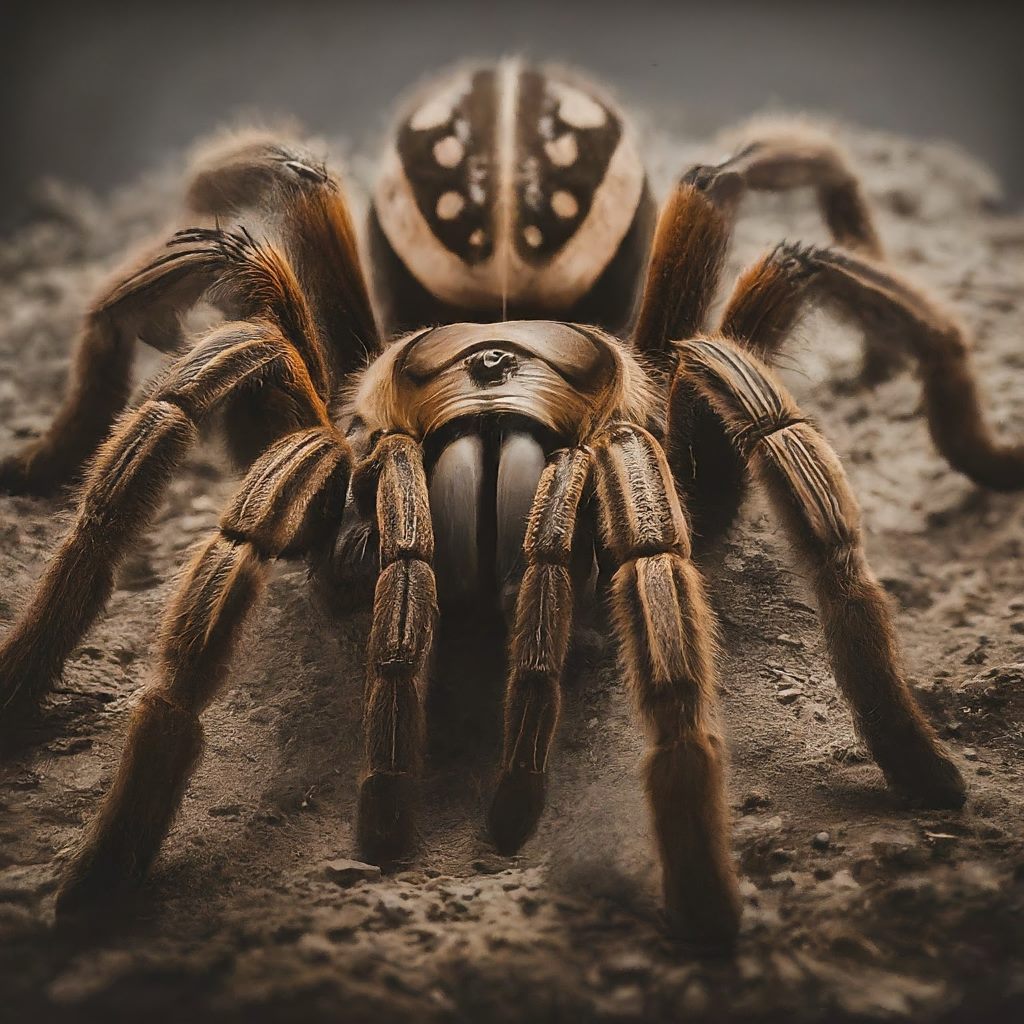
- Physical Characteristics: Pelinobius muticus is known for its large size and distinctive markings, with a dark-colored body and dense, bristly hairs.
- Size, Color, and Weight: Adults can have a leg span of up to 8-9 inches and are typically dark brown or black in color.
- Lifespan: They have a lifespan of around 15-20 years in captivity.
- Prey and Diet: Their diet primarily consists of insects and other small invertebrates, and they are known to be opportunistic feeders.
- Behavior: These tarantulas are generally defensive and may exhibit aggressive behavior if threatened. They are primarily terrestrial and may burrow for shelter.
- Habitat: Found in the savannas and grasslands of East Africa, particularly in Kenya and Tanzania.
- Web: They may spin silk-lined burrows for shelter but do not heavily rely on webbing for hunting.
- Temperament: Known for their defensive nature, they may bite if provoked, and handling should be approached with caution.
Namibian Golden Blue Leg Baboon Tarantula – Harpactirella lightfooti:
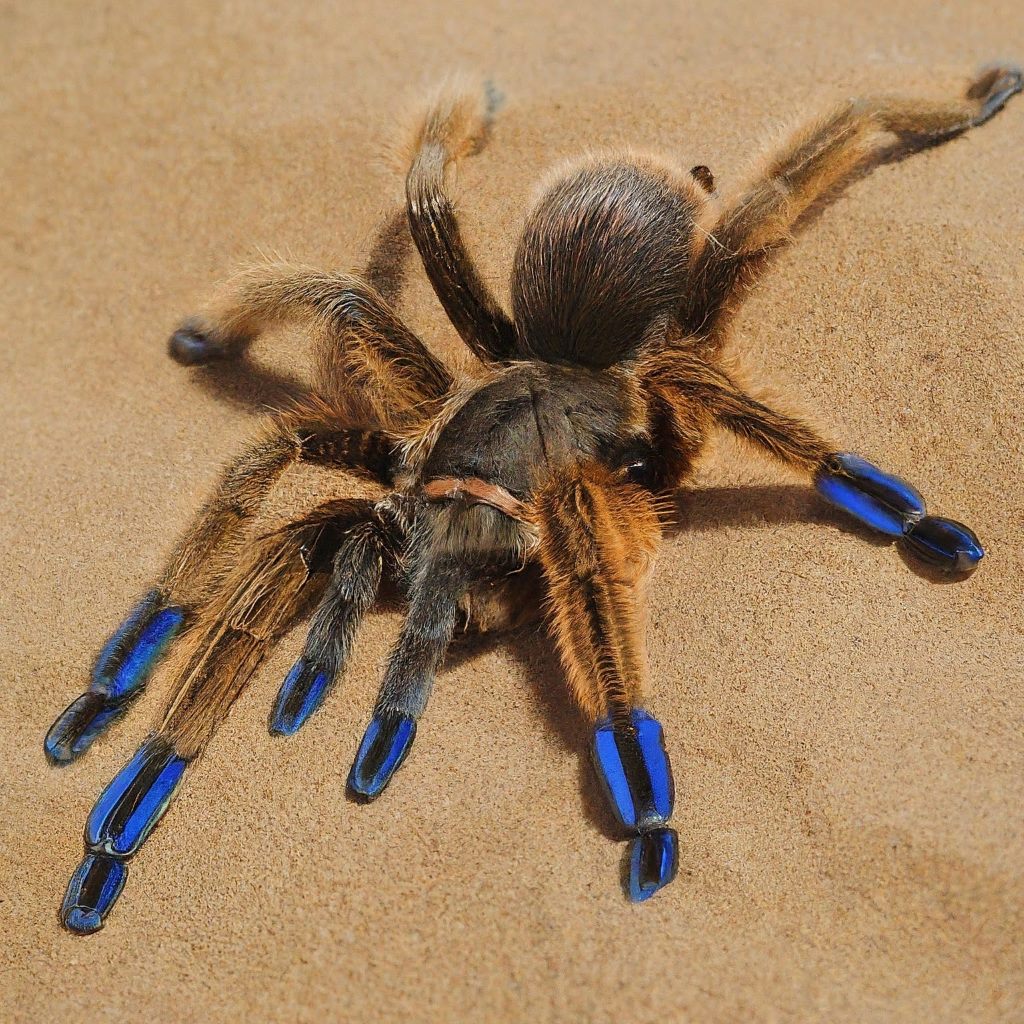
- Physical Characteristics: Harpactirella lightfooti is known for its striking golden-blue leg coloration and robust build.
- Size, Color, and Weight: Adults have a leg span of around 4-5 inches and are typically dark brown or black with bright blue legs.
- Lifespan: They have a lifespan of around 8-10 years in captivity.
- Prey and Diet: Their diet mainly consists of insects and other small invertebrates, and they are known to be fast and efficient hunters.
- Behavior: These tarantulas are generally defensive and may exhibit aggressive behavior if threatened. They are primarily terrestrial and may burrow for shelter.
- Habitat: Found in the deserts and arid regions of Southern Africa, particularly in Namibia.
- Web: They may spin silk-lined burrows for shelter but do not heavily rely on webbing for hunting.
- Temperament: Known for their defensive nature, they may bite if provoked, and handling should be approached with caution.
OBT (Orange Baboon Tarantula) – Pterinochilus murinus:
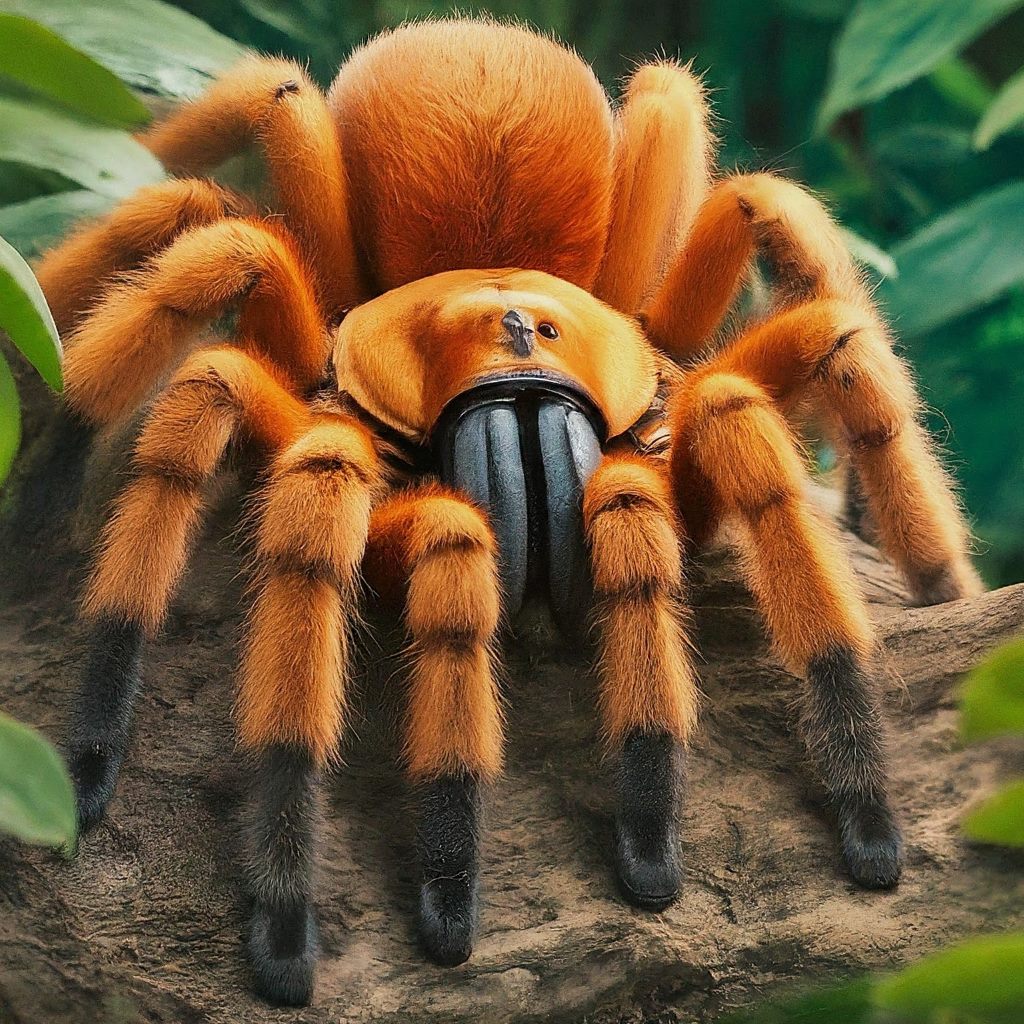
- Physical Characteristics: Pterinochilus murinus is known for its vibrant orange coloration and robust build, with dense, bristly hairs.
- Size, Color, and Weight: Adults have a leg span of around 5-6 inches and are typically bright orange in color.
- Lifespan: They have a lifespan of around 8-10 years in captivity.
- Prey and Diet: Their diet primarily consists of insects and other small invertebrates, and they are known to be aggressive hunters.
- Behavior: These tarantulas are highly defensive and may exhibit aggressive behavior if threatened. They are primarily terrestrial and may burrow for shelter.
- Habitat: Found in the savannas and grasslands of East Africa, particularly in Kenya and Tanzania.
- Web: They may spin silk-lined burrows for shelter but do not heavily rely on webbing for hunting.
- Temperament: Known for their aggressive nature, they may bite if provoked, and handling should be approached with extreme caution.
Sapphire Gooty Tarantula – Poecilotheria metallica:
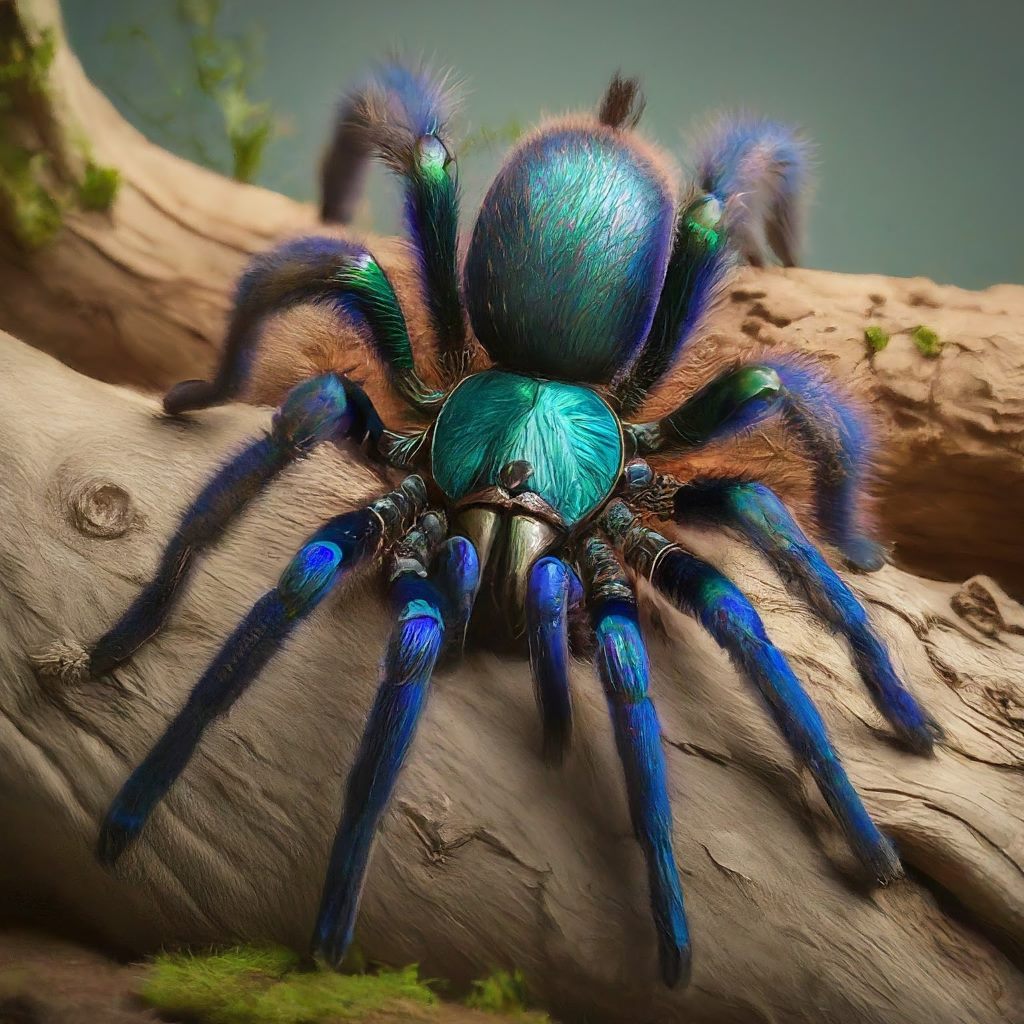
- Physical Characteristics: Poecilotheria metallica is known for its dazzling blue metallic coloration and intricate patterns on its legs and abdomen.
- Size, Color, and Weight: Adults have a leg span of around 6-7 inches and are typically blue with black markings.
- Lifespan: They have a lifespan of around 8-10 years in captivity.
- Prey and Diet: Their diet mainly consists of insects and other small invertebrates, and they are known to be agile hunters.
- Behavior: These tarantulas are generally defensive and may exhibit aggressive behavior if threatened. They are arboreal and may create silk retreats in trees or foliage.
- Habitat: Found in the dense forests of Southern India, particularly in the Gooty region.
- Web: They may spin intricate webs in trees or foliage for shelter and hunting.
- Temperament: Known for their defensive nature, they may bite if provoked, and handling should be approached with caution.
Skeleton Tarantula – Ephebopus murinus:
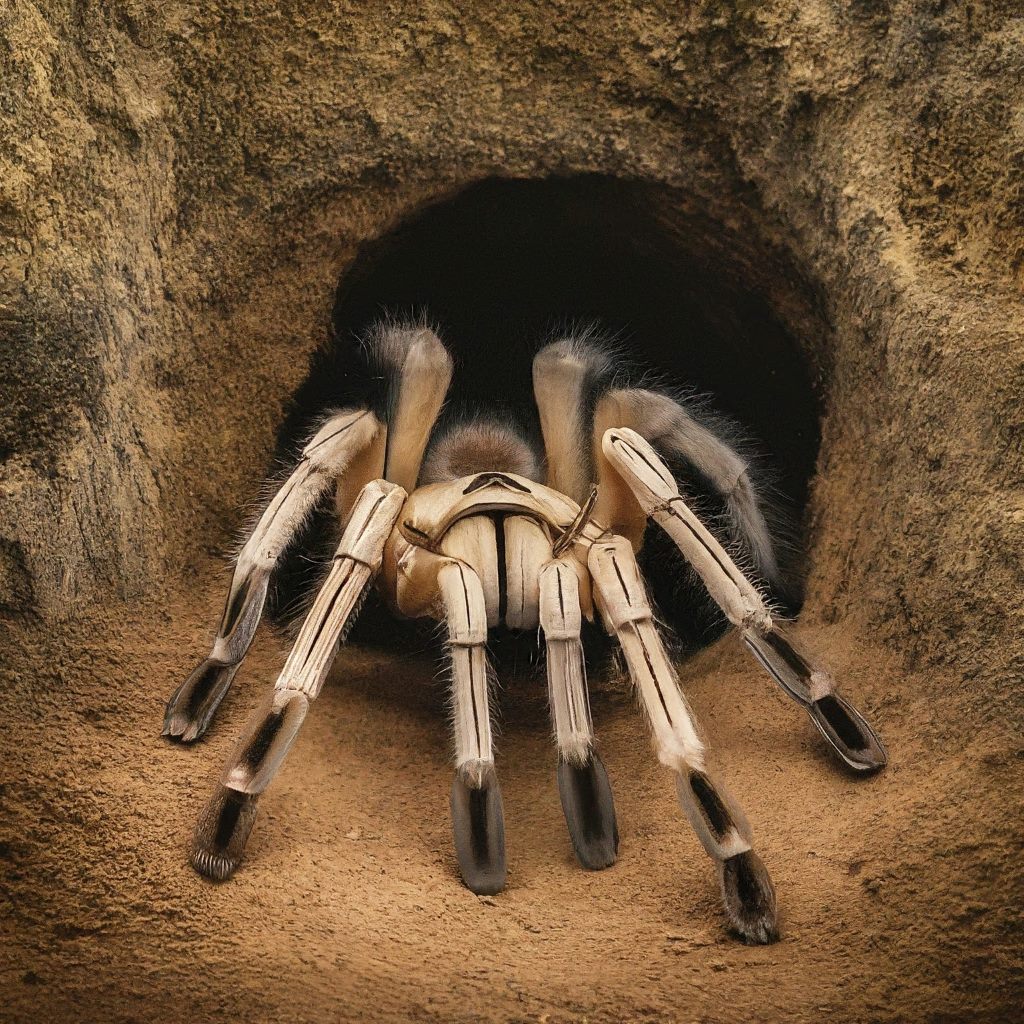
- Physical Characteristics: Ephebopus murinus is known for its unique skeletal-like markings on its legs and abdomen.
- Size, Color, and Weight: Adults have a leg span of around 4-5 inches and are typically brown or black with white markings.
- Lifespan: They have a lifespan of around 8-10 years in captivity.
- Prey and Diet: Their diet mainly consists of insects and other small invertebrates, and they are known to be agile hunters.
- Behavior: These tarantulas are generally defensive and may exhibit aggressive behavior if threatened. They are terrestrial and may burrow for shelter.
- Habitat: Found in the rainforests of South America, particularly in Guyana and Suriname.
- Web: They may spin silk-lined burrows for shelter but do not heavily rely on webbing for hunting.
- Temperament: Known for their defensive nature, they may bite if provoked, and handling should be approached with caution.
Thailand Black Velvet Tarantula – Thrigmopoeus psychedelicus:
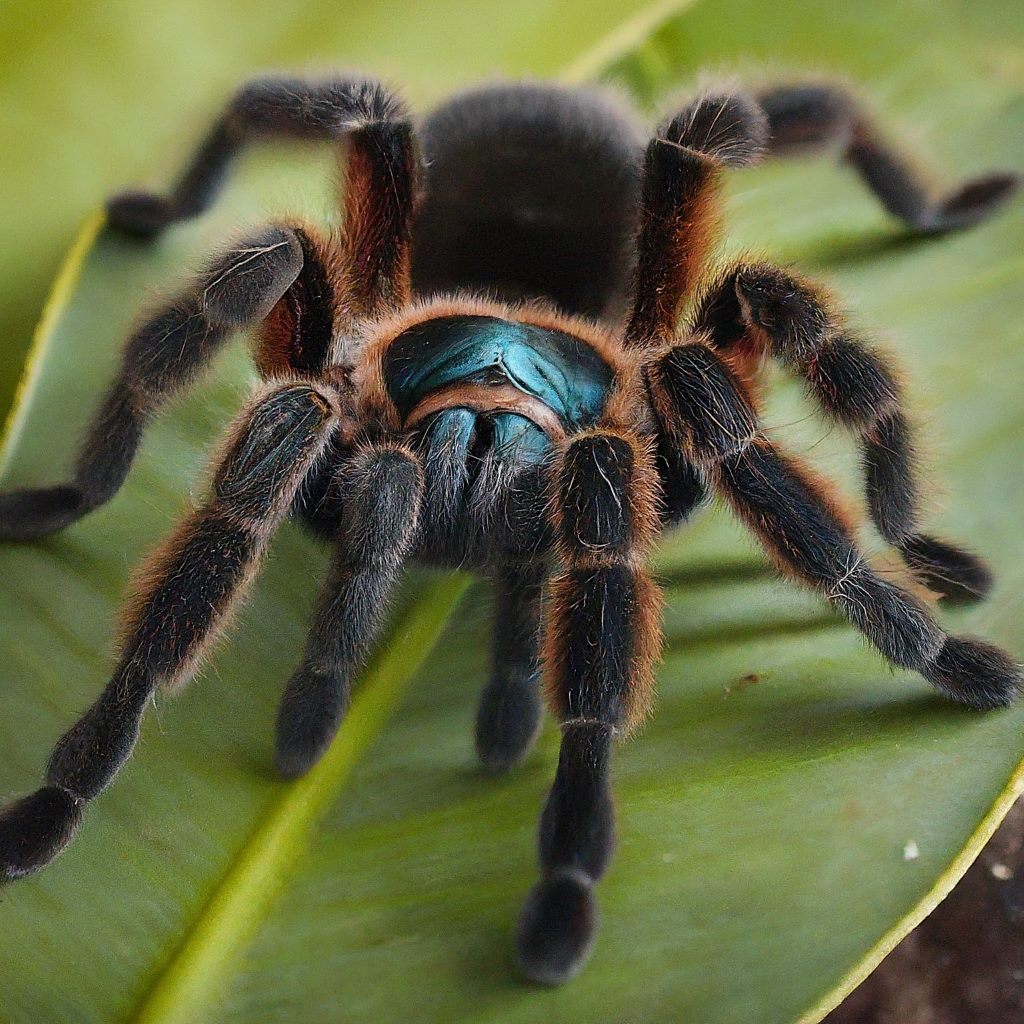
- Physical Characteristics: Thrigmopoeus psychedelicus is known for its deep black velvety appearance and robust build.
- Size, Color, and Weight: Adults have a leg span of around 7-8 inches and are typically black with a velvety texture.
- Lifespan: They have a lifespan of around 10-12 years in captivity.
- Prey and Diet: Their diet primarily consists of insects and other small invertebrates, and they are known to be opportunistic feeders.
- Behavior: These tarantulas are generally defensive and may exhibit aggressive behavior if threatened. They are terrestrial and may burrow for shelter.
- Habitat: Found in the forests and woodlands of Thailand, particularly in the northern regions.
- Web: They may spin silk-lined burrows for shelter but do not heavily rely on webbing for hunting.
- Temperament: Known for their defensive nature, they may bite if provoked, and handling should be approached with caution.
Togo Starburst Baboon Tarantula – Heteroscodra maculata:
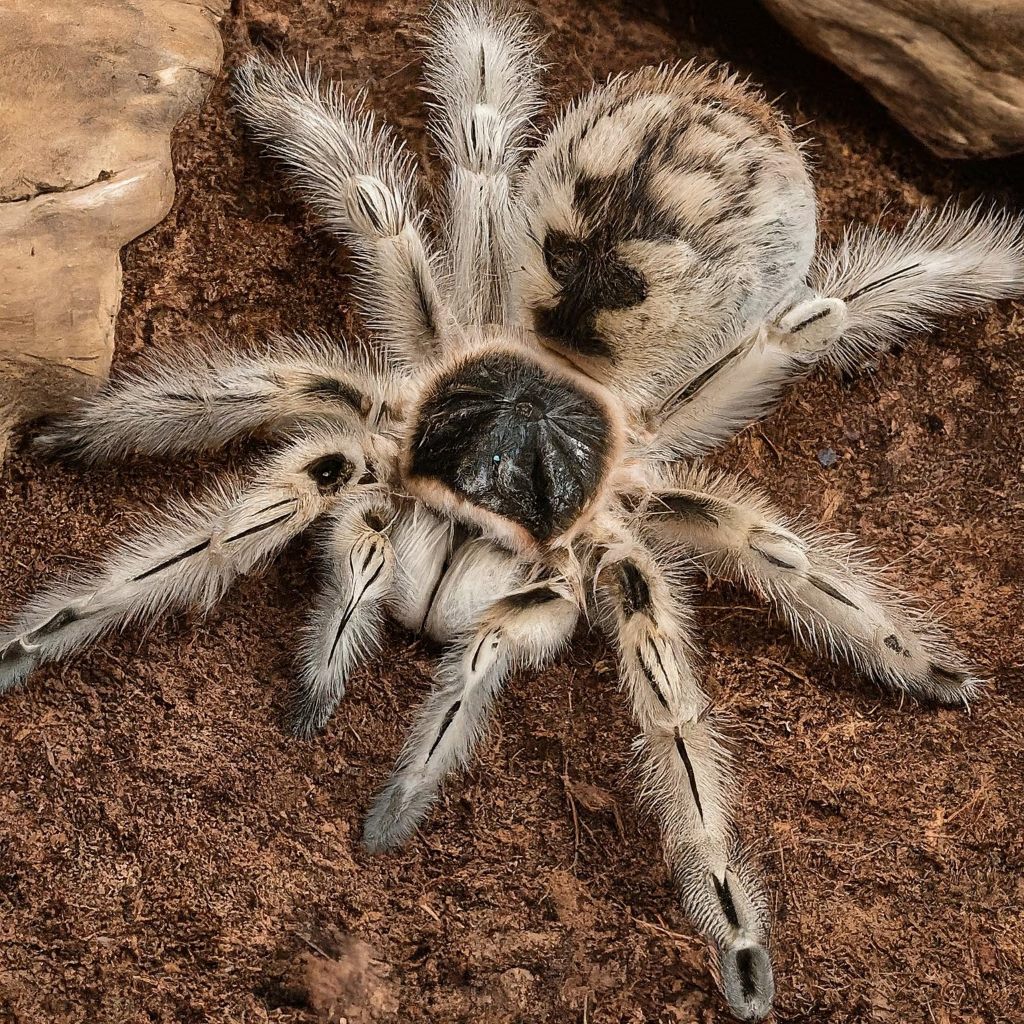
- Physical Characteristics: Heteroscodra maculata is known for its striking starburst pattern on its abdomen and distinctive markings.
- Size, Color, and Weight: Adults have a leg span of around 5-6 inches and are typically brown or tan with darker markings.
- Lifespan: They have a lifespan of around 8-10 years in captivity.
- Prey and Diet: Their diet mainly consists of insects and other small invertebrates, and they are known to be aggressive hunters.
- Behavior: These tarantulas are highly defensive and may exhibit aggressive behavior if threatened. They are primarily terrestrial and may burrow for shelter.
- Habitat: Found in the forests and woodlands of West Africa, particularly in Togo and Ghana.
- Web: They may spin silk-lined burrows for shelter but do not heavily rely on webbing for hunting.
- Temperament: Known for their defensive nature, they may bite if provoked, and handling should be approached with extreme caution.
Venezuelan Suntiger Tarantula – Psalmopoeus irminia:
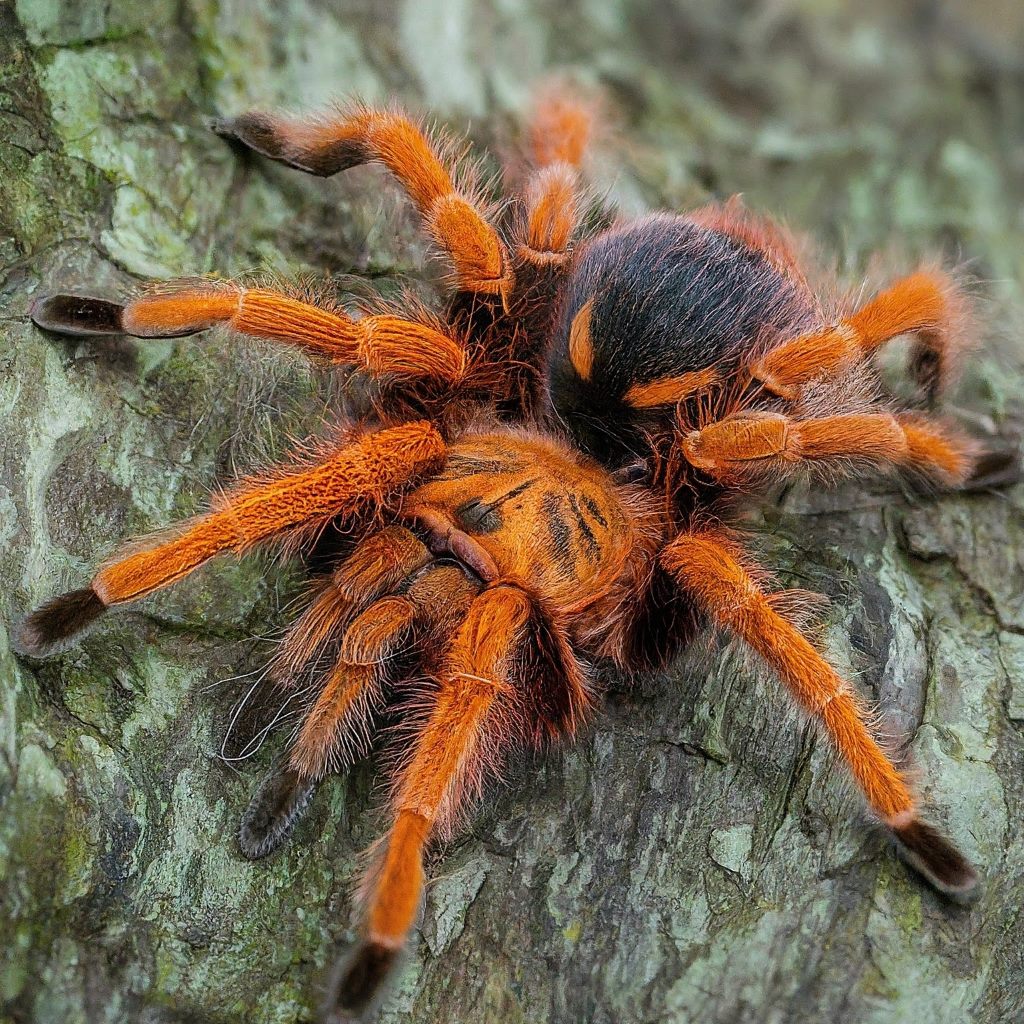
- Physical Characteristics: Psalmopoeus irminia is known for its vibrant orange and black coloration and distinctive tiger-like stripes.
- Size, Color, and Weight: Adults have a leg span of around 6-7 inches and are typically orange with black markings.
- Lifespan: They have a lifespan of around 8-10 years in captivity.
- Prey and Diet: Their diet primarily consists of insects and other small invertebrates, and they are known to be agile hunters.
- Behavior: These tarantulas are generally defensive and may exhibit aggressive behavior if threatened. They are arboreal and may create silk retreats in trees or foliage.
- Habitat: Found in the forests and woodlands of Venezuela, particularly in the northern regions.
- Web: They may spin intricate webs in trees or foliage for shelter and hunting.
- Temperament: Known for their defensive nature, they may bite if provoked, and handling should be approached with caution.
Summary
The world of tarantulas is vast and diverse, encompassing a wide range of species with varying characteristics and behaviors. Among them, certain tarantulas stand out for their aggressive tendencies and potent venom, making them both fascinating and formidable creatures. In this guide, we have explored some of the most aggressive and poisonous tarantulas, highlighting their physical features, behaviors, habitats, and more. From the African Rear-Horned Baboon Tarantula to the Venezuelan Suntiger Tarantula, each species offers its own unique traits and challenges for enthusiasts and researchers alike. By understanding these tarantulas’ characteristics and behaviors, we gain insight into their role in the natural world and the importance of conservation efforts to protect these remarkable creatures.
FAQs (Frequently Asked Questions):
- Are all tarantulas aggressive and poisonous?
- No, not all tarantulas are aggressive or possess potent venom. While some species exhibit defensive behaviors when threatened, many tarantulas are docile and pose little threat to humans.
- How can I tell if a tarantula is aggressive?
- Aggressive tarantulas may display defensive behaviors such as rearing up on their hind legs, hissing, or striking if threatened. It’s essential to observe their body language and respect their boundaries to avoid provoking them.
- What should I do if I encounter an aggressive tarantula?
- If you encounter an aggressive tarantula, it’s best to avoid provoking it and give it space. Back away slowly and allow the tarantula to retreat to safety. Attempting to handle or agitate an aggressive tarantula can result in defensive behavior or bites.
- Are aggressive tarantulas suitable as pets?
- Aggressive tarantulas can be challenging to care for and handle, especially for novice keepers. While experienced enthusiasts may appreciate the unique characteristics of aggressive species, it’s crucial to research their care requirements thoroughly and approach handling with caution.
- What precautions should I take when keeping aggressive tarantulas as pets?
- When keeping aggressive tarantulas as pets, it’s essential to provide secure enclosures with minimal opportunities for escape. Additionally, always use caution when handling these species and wear appropriate protective gear to minimize the risk of bites. Regular research and education on tarantula behavior and care are also essential for responsible ownership.

94% of pet owners say their animal pal makes them smile more than once a day. In 2007, I realized that I was made for saving Animals. My father is a Vet, and I think every pet deserves one. I started this blog, “InPetCare”, in 2019 with my father to enlighten a wider audience.
